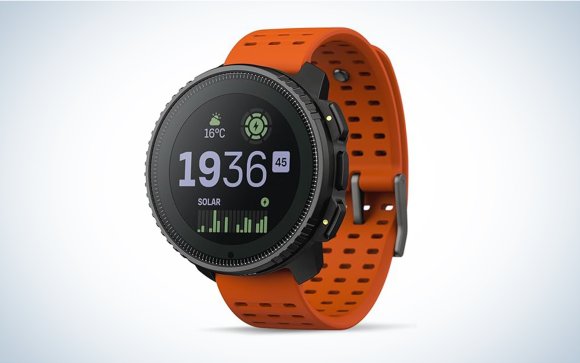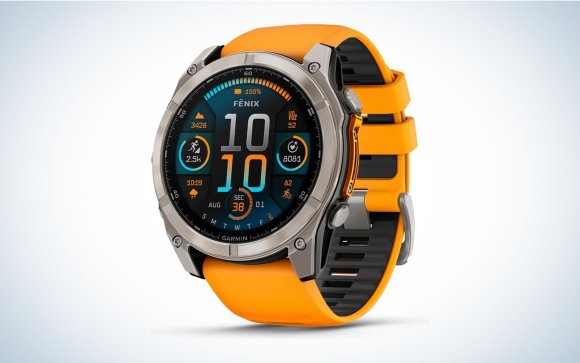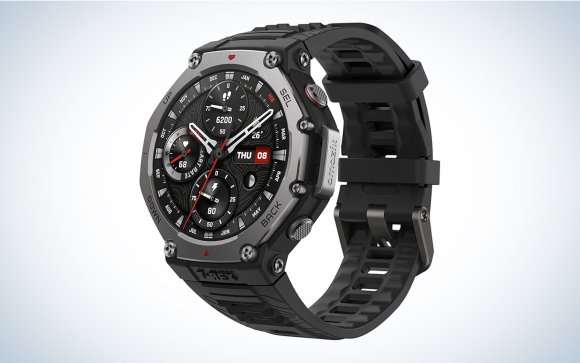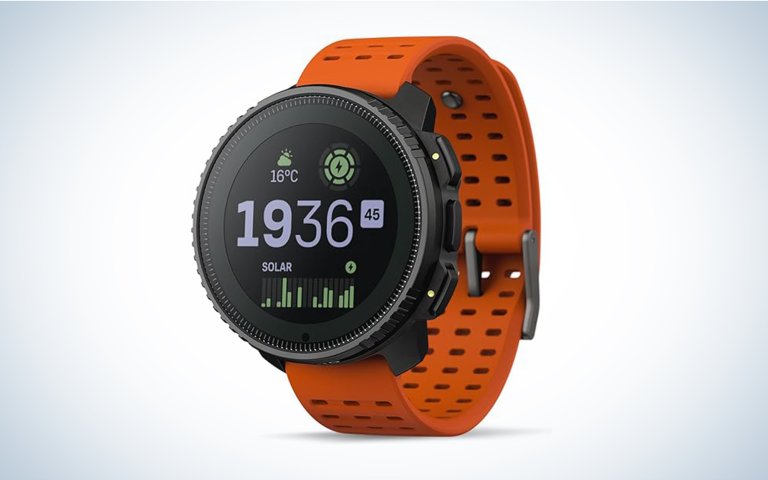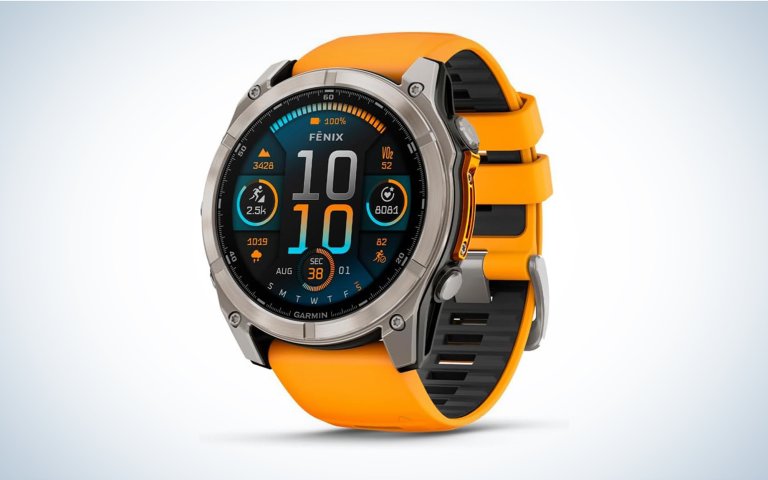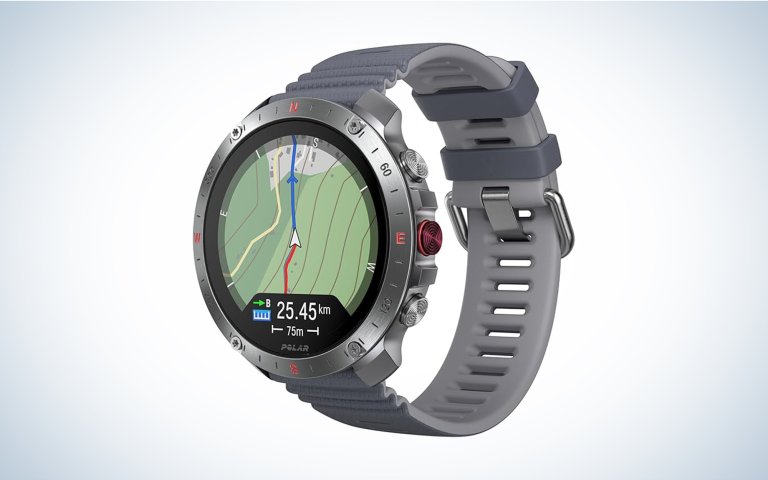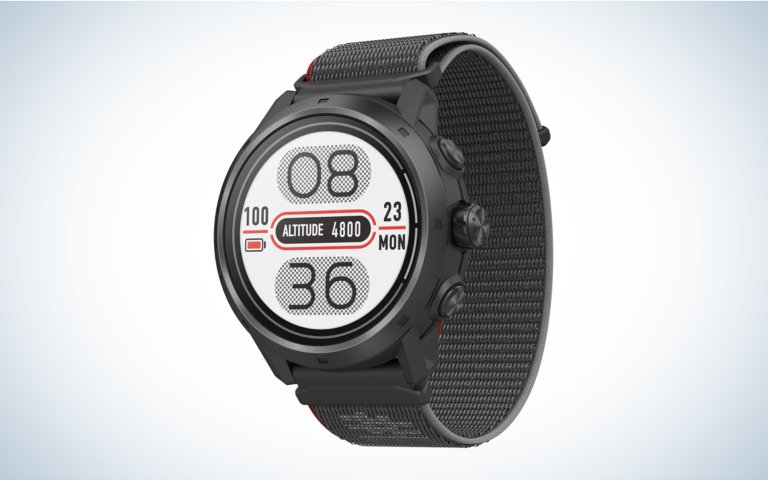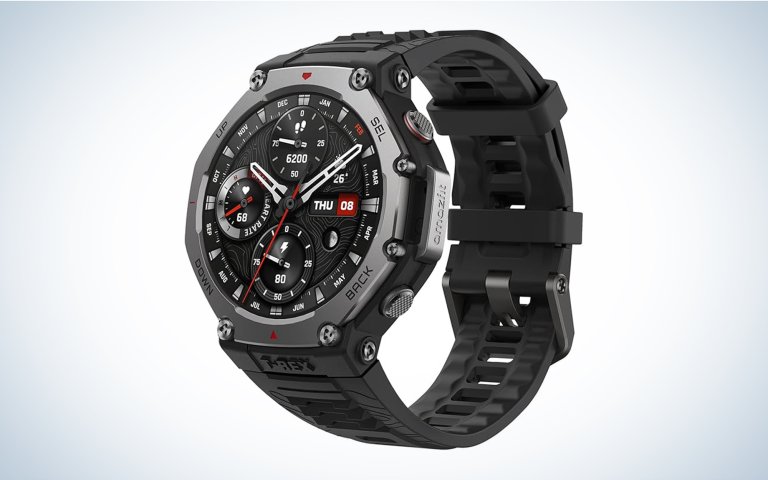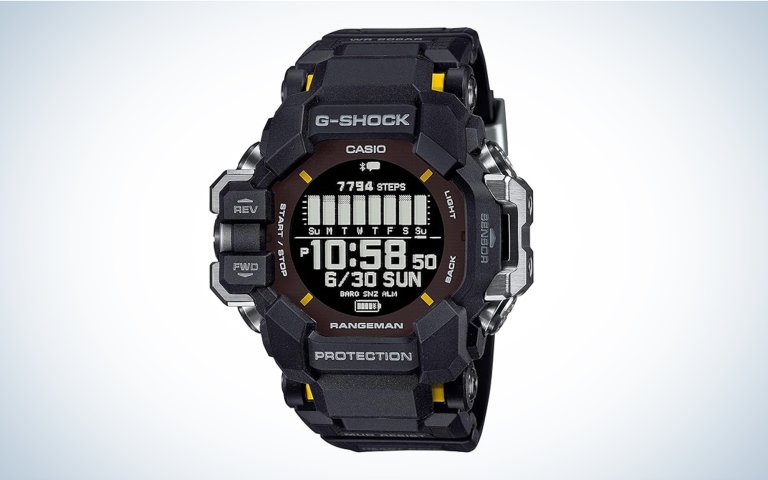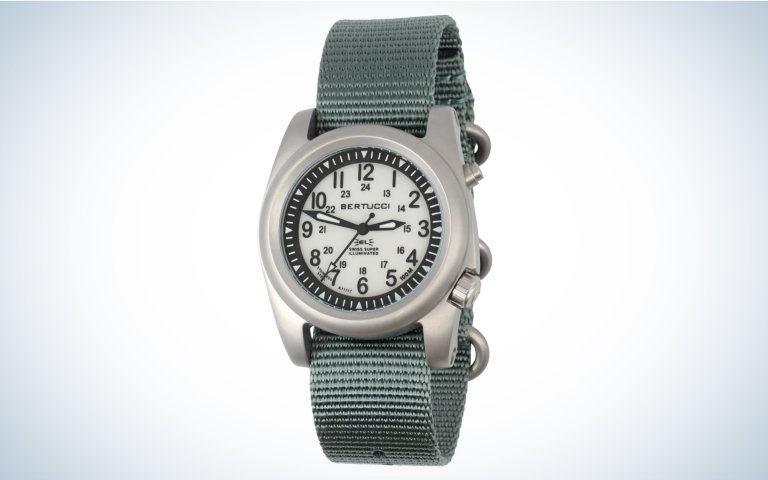We may earn revenue from the products available on this page and participate in affiliate programs. Learn More ›
Believe it or not, hiking watches with GPS capabilities, training modules, and activity tracking have been around for decades. However, the contrast between early smartwatches and today’s technology is pretty mind-blowing. Nowadays, the innovation translates to wearing a mini computer on your wrist that measures — quite possibly — more than you want to know. This roundup includes the best hiking watches on the market. Many of my top picks are new to the smartwatch scene and move their predecessors into the shadows.
- Best Overall: Suunto Vertical
- Best Features: Garmin fenix 8
- Best for Training: Polar Grit X2 Pro
- Most User Friendly: Corus Apex 2 Pro
- Best Budget: Amazfit T-Rex3
- Most Rugged: Casio GPRH 1000-1
- Best Field Watch (Non GPS): Bertucci #22033 A-2sel
How We Tested the Best Hiking Watches

My wife and I are hiking guides in Alaska, but we tested the best hiking watches across the globe from southern Spain to northern Alaska. To give a brief background of our history with smartwatches, we wore GPS watches on both our 2011 and 2014 thru hikes. Of course, back then, the watches were simpler, merely telling the time while tracking mileage and elevation (and heart rate if you wanted to buy an additional component). There was no pairing with a smartphone or any other fancy features, like time to recovery or sleeping data.
But the six hiking watches we tested this fall have tons of applicable trekking features. With only two wrists, we split the devices between us over the course of two months. We walked, hiked, ran on a treadmill, biked, kayaked, caved, skied, snowshoed, and slept while wearing these watches daily to get an idea of how they integrate into the lives of active outdoors people, with a focus on hiking.
GPS watches are incredibly nuanced, so when we could just charge up a watch, slap it on our wrist, and go out for an adventure, we took note. Much of our testing focused on ease of use, mapping abilities, aesthetics, comfort, features, price, and weight. Though we also performed a few controlled tests on the best hiking watches for GPS accuracy and usability in freezing temperatures.
GPS Accuracy
It was helpful in our test to conduct a few head-to-head comparisons. Given these are GPS watches, the most important metric to compare was the accuracy of the location recordings. On one of our hikes, we synchronized the starts of all six watches and compared the mileage, ascent, and descent. There was a quarter-mile difference in the track recordings, with the Coros Apex 2 Pro being the lowest and the Casio GPRH 1000-1 being the highest. The variability in elevation was greater, with nearly 100 feet of discrepancy.
Freezing Temps

Because we live in Alaska, it was also important to us to conduct a temperature test. Cold typically zaps batteries on tech, however, all of the watches were able to withstand the subzero conditions of our outdoor activities. The Suunto Vertical definitely surpassed all the watches in the test for its battery life.
Here are our trail-tested reviews of the best hiking watches.
Best Hiking Watches: Reviews & Recommendations
Best Overall: Suunto Vertical
Pros
- Slim sapphire crystal glass face
- Titanium bezel
- Solar charging capability
- 95+ sport modes
- Comfortable watch band
Cons
- Finicky charging connection
- Takes some time to learn to use
Key Features
- Weight: 2.61 ounces
- Water Resistant: 328 feet
- Number of Buttons: Three
- Battery Life: 65 hours to 1 year (solar)
- Compatibility: Suunto App
- Price: $839
It was truly a neck-and-neck battle between the Suunto Vertical and Garmin Fenix 8 as to which was the best overall. They offer similar features, but ultimately Suunto was a lighter and more comfortable watch to wear every day (and night). Not only was the silicone watch band the most breathable and softest to the skin in the test, the fit was exceptional. The band design utilizes a small snap that can fit in any of the 100 holes, thus providing a tailored fit.
Not being tech-savvy meant we had to play around with the watch for a while before mastering the customizable features, but with only three buttons and an easy-to-use touch screen, it wasn’t too confusing. Everything about the Suunto felt manageable, with no overkill on features or design elements. Might I add, its sleek look is aesthetically pleasing to go from trail to town.
Even though the charging connection doesn’t always stay put, the solar power component meant I had to charge it less. At the $839 price point, we were shocked there was solar capability. If you opted for the steel bezel versus titanium bezel, it’s even cheaper.
Best Features: Garmin fenix 8
Pros
- Large sapphire crystal glass face with color screen
- Four-way flashlight, with red
- 100+ sport modes
- Three bezel sizes
- Option for solar
Cons
- Heavy
- Expensive
Key Features
- Weight: 3.25 ounces (51mm)
- Water Resistant: 328 feet
- Number of Buttons: Five
- Battery Life: 29 hours to 31 days
- Compatibility: Garmin App
- Price: $1,200
As I said, this watch could have been awarded best overall, but it offers more than is necessary for everyday adventurers like ourselves. And the price is a deterrent. The first GPS watch I owned was a Garmin Forerunner 110. And although so much has changed in what their products can do, what hasn’t changed is how user-friendly Garmin products are right out of the box.
Thanks to the amoled glass, the maps are crisp on the large, bright display. That being said, the watch is heavy and bulky, so much so that I was afraid I’d knock my partner out in the night while wearing it for the sleep stats. It wouldn’t be my go-to choice for everyday wearing, more so for longer expeditions when you need more features.

What sets this watch apart from others is voice command. I could tell it to start, stop, and pause activities, control music, send texts, and even find my phone. You can also make calls, and perfectly hear the person on the other end.
I absolutely loved the four-way flashlight, which even has a red mode. The highest white setting was powerful enough to guide our way up 99 stairs with luggage and unlock the door to our Airbnb during a power outage in Spain.
Best for Training: Polar Grit X2 Pro
Pros
- Sapphire glass face
- 150+ sport modes
- Slim design
Cons
- Not intuitive to use
Key Features
- Weight: 2.8 ounces
- Water Resistant: 328 feet
- Number of Buttons: Five
- Battery Life: 43 hours to 10 days
- Compatibility: Polar Flow App, Strava, Training Peaks, My Fitness Pal, Kommot
- Price: $750
Serious athletic training requires more informed metrics during workouts, and that’s the calling card of the Polar. The Polar app is where you discover all the possibilities of setting goals, creating different profiles for various sports, and analyzing training details, admittedly more of a toolkit than our two months of testing and amateur athleticism could digest. We even struggled a bit with the setup, having to consult one another to get the watch to sync with the phone app.

Beyond the feature-rich interface and the compatibility with other training apps, this computer on your wrist is equal parts lightweight, sleek, and durable to take the beating hardcore training entails. It comes with two watch band sizes, which worked well since we both have different size wrists.
There were a few frustrating gripes about the Polar, but one in particular was the brightness of the green light under the watch face. It’s only a problem if you plan to wear the watch while sleeping because your wrist will be glowing. All the watches have some sort of light that stays on during the night for sleep tracking, but the Polar was downright obnoxious.
It’s worth noting that the watch face layout options on the Polar were not as extensive as the other watches, but the Polar’s face was extremely legible with its red and white large format time and date, even with our old-person peepers.
Most User Friendly: Corus Apex 2 Pro
Pros
- Sapphire glass face
- Comfortable nylon watch band with Velcro closure
- Simple to use
- Affordable
- Spin dial
Cons
- Finicky charging connection
- No flashlight
Key Features
- Weight: 1.9 ounces (nylon band)
- Water Resistant: 164 feet
- Number of Buttons: Three (with a scrolling wheel)
- Battery Life: 9 hours to 21 days
- Compatibility: Corus App, GoPro, Insta360
- Price: $450
Setup of both the watch and app didn’t require any semblance of an engineering degree, making this device perhaps the best choice for first-time GPS watch wearers. Having only three buttons speaks volumes about its ease of use, as the top button is for illumination and the bottom button is for going back or selecting a change. The middle button is a scrolling wheel to find all the other features, something other watches lacked, and the touchscreen also navigates through the options. The watch locks, which means there can’t be any accidental pushes of the buttons. However, even on the locked screen, you can interchange the metrics displayed (depending on which screen face you’ve chosen).

A standout characteristic was the nylon watch band. Not only was it more comfortable on the skin overnight and lightweight, the Velcro closure allowed for micro-adjustments, making it the best fitting for small wrists.
The 21-day battery life impressed us, as we only needed to charge this after daily use every three weeks. However, one ding related to charging was the charging port took some effort to keep it in place.
Best Budget: Amazfit T-Rex3
Pros
- Affordable
- 170+ activities
Cons
- Cheaper materials for watch band and glass face
- Screen too dim to read under bright sunlight
Key Features
- Weight: 2.4 ounces (without strap)
- Water resistant: 328 feet
- Number of buttons: 4
- Battery life: 42 hours to 27 days
- Compatibility: Zepp App, Phone camera
- Price: $280
At a sub $300 price, this device casts a wide net of the market, from beginners to serious athletes thanks to its robust arsenal of activities to track and a few other exclusive aspects that felt like bonuses. For example, the watch can work as a remote to take a photo with your phone.
With 170+ activities to track metrics, the options felt like overkill. Do we really need to know what our max/min heart rate was and how few calories we burned during leisure activities, like swinging on a swingset and playing a board game? We did appreciate how they were broken down by category — e.g., 27 indoor workouts, 16 dance workouts — when perusing through the options.
Performance-wise, this value-based choice did as well as many of the other watches. The Amazfit app (called Zepp) was so detailed with its summaries. The watch face had sleek hardware and in fact, the four buttons around the bezel are labeled (Up, Down, Sel, Back), which aids in its simplicity. We’d like to crown this watch the “friendliest.” The “Good Morning!” message announcing the weather, as well as the reminders to stand up after sitting for 45 minutes, were like hearing from a friend. The watch does show texts and push alerts coming to your phone, but we noted how it disappears quickly, so could be missed.
With that being said, there were attributes where the lower price point was evident. For example, the stock-silicone strap was the least comfortable of all the watch bands, getting particularly sweaty during workouts and sleep. Also, the anti-reflective coating of the Gorilla glass seemed sub-par compared with the Sapphire glass used on the other watches. In direct sun, there was a glare making it impossible to read the watch face. Additionally, the battery says it has a range of 42 hours to 27 days, but the test fell short of those stats.
Most Rugged: Casio GPRH 1000-1
Pros
- Durable
- Easy to use
- Big buttons
Cons
- Bulky with a small watch face
- No touchscreen, color, or mapping on watch face
- Watch clasp pitches skin
Key Features
- Weight: 3.25 ounces
- Water Resistant: 656 feet
- Number of Buttons: 5 buttons
- Battery Life: 14 hours to 23 months
- Compatibility: Casio App and Strava
- Price: $500
This watch is a beast. Durability-wise, I haven’t found a way to damage it, even after brushing up against limestone while caving, banging it against my kayak while paddling, or tearing through thick willow thickets off trail. Heavy-duty metal guards protect the buttons from unintentional engagement, plus the buttons are equipped with specialized gaskets that prevent mud, dust, and water from getting into the watch. Further, there is a plastic resin raised over the glass face surrounding the bezel, versus the other watches which have stainless steel bezels prone to scratches and nics. With 650 feet of water resistance, it probably is also the best choice for divers and other water sports enthusiasts.
Given it is a bit clunky, it wasn’t the most comfortable to wear every day, and particularly dangerous to sleep with as it could be a weapon against my partner. The heavy duty metal clasp on the watch band would also pinch my skin occasionally. In general, it is not as sleek-looking as the other designs. I felt like I was a Transformer ready for all the things when wearing it.
Even with five buttons, it was pretty easy to learn to use, especially because each button is labeled. It is surprising that you can only see the map on the phone app when using it for “trekking” activities; it would be helpful to see it on the watch face, although the screen is small and not colored.
We did note that this watch did take a bit more time to link with the satellites than the others.
Best Field Watch (Non GPS): Bertucci #22033 A-2sel
Pros
- Dual illumination
- Heavy duty nylon watch band
- Affordable
Cons
- Not a smart watch with GPS
- Stainless steel casing
Key Features
- Weight: 2.75 ounces
- Water resistant: 656 feet
- Number of buttons: 2 buttons
- Battery life: 4 years
- Compatibility: NA
- Price: $175
Sometimes I just want to keep it simple and don’t want all that technology in the backcountry. My first Bertucci watch has withstood the elements for the last 5+ years. This newer updated version has a heavy duty nylon band and is very comfortable with two fixed metal loops to hold the strap. The band breathes well, dries quickly, and never smells. The markers and hands stay illuminated in low light conditions with no battery use. An upper button activates a soft blue light for three seconds. The specs say the battery life is four years, but mine is on the same battery as when I first got it over half a decade ago.
Things to Consider Before Buying the Best Hiking Watch

Hiking Watch Prices
Price is probably the biggest consumer concern, and the watches in this test range from $280 to $1,200. You might be scratching your head wondering if you need the higher-end sapphire crystal glass, or if you can get away with the Gorilla glass found on the more affordable Amazfit. If you are looking to hit the trail running, you might not need the dizzying list of features on the higher end hiking watches. Even the budget-friendly devices like Coros and Amazfit performed superbly.
Hiking Watch Features
Another factor with smartwatches is just how involved you are with your training. Most of the watches provide a range of metrics like pace, heart rate, and calories burned. However, the more sophisticated brands like Polar, Suunto, and Garmin provide deeper insights, almost like a personal coach.
Many watches specialize in certain activities and features, so you need to read the details of each watch to match it to your personal preference and needs. For example, if you are a freediver, the waterproofing is most important and the Casio might be the best fit. If you are spending weeks out on a climbing expedition, the battery life is crucial, so the Suunto and Garmin with solar capabilities would be good choices. If you can’t get enough statistics in your training, then the Polar is a stellar choice. Users should understand what tools they desire in a watch before dropping dough.
Hiking Watch Sizes
Lastly, the designs vary from light and slim, to bulkier and more durable. If you plan on wearing your watch every day or while you sleep, the size and comfort is important, otherwise you have a pricey piece of tech taking up space in your gear closet.
Hiking Watch FAQs
You’ll need Internet or a cell signal to initially connect the watch to your phone and to sync data to the phone after training, but you don’t need it while using your hiking watch. GPS watches operate via satellites. It shouldn’t take more than a few minutes to obtain a location on the watch with a clear view of the sky, but doing so in a sheltered area like a canyon versus on an exposed ridge would be the reason for any delays. You shouldn’t solely rely on a GPS watch as your only means of figuring out your location; a paper map and compass are critical tools.
Many GPS watches are heavily focused on training and tracking metrics — heart rate, speed, and more — so only you can answer if that is something you are interested in connected to your activity. There are other ways to navigate besides a GPS watch, but knowing what time it is keeps your adventure plans on track.
Final Thoughts on the Best Hiking Watches
We live in a time of self-awareness, so having a watch that measures every detail about your well-being can be beneficial. The options for GPS hiking watches are bountiful, so there is something for every kind of athlete. From everyday use to hardcore training, this list of best hiking watches will help you decide what data-tracking time-piece is best for you.
- Best Overall: Suunto Vertical
- Best Features: Garmin fenix 8
- Best for Training: Polar Grit X2 Pro
- Most User Friendly: Corus Apex 2 Pro
- Best Budget: Amazfit T-Rex3
- Most Rugged: Casio GPRH 1000-1
- Best Field Watch (Non GPS): Bertucci #22033 A-2sel

